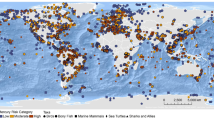Abstract
The definitions of the notions ‘bio-indicator’ and ‘water quality’ are critically reviewed; it is shown that both have been used ambiguously.
The quality of the Wadden Sea is discussed using a number of indicators for pollution effects; the Wadden Sea is now an unsuitable environment for a number of marine mammals, and, to a lesser extent, for some bird species. It cannot be shown whether or not this pollution has any effect on r-selective species.
Similar content being viewed by others
References
Bouwman, L. A.: 1981, ‘The Meiofauna of the Ems Estuary’, in N. Dankers, H. Kühl, and W. J. Wolf, Invertebrates of the Wadden Sea, Balkema, Rotterdam, pp. 153–157.
Cairns, J. and Schalie, W. H. van der: 1980, ‘Biological Monitoring — Eearly Warning Systems’, Water Res. 14, 1179–1196.
Colinvaux, P.: 1980, Why Big Fierce Animals Are Rare, George Allen and Unwin, pp. 1–224. Pelican Books.
Coull, B. C., Hicks, G. R. F., and Wells, J. B. J.: 1981, ‘Nematode Copepod Ratios for Monitoring Pollution: A Rebuttal’, Mar. Poll. Bull. 12 (11): 378–381.
Dankers, N., Kühl, H., and Wolff, W. J.: 1981, Invertebrates of the Wadden Sea, Stichting Veth, Balkema, Kotterdam, pp. 1–221.
Duinker, J. C. and Hillebrand, M. T. J.: 1979. ‘Mobilisation of Organochlorines from Female Lipid Tissue and Transplacental Transfer to Foetus in a Harbour Porpoise (Phocaena phocaena) in a Contaminated Area’, Bull. Env. Contam. Toxicol. (U.S.) 23, 723–728.
Dijksen, A. J. and Dijksen, L. J.: 1977, Texel Bird-Island, Thieme, Zutphen, pp. 140–141 (in Dutch).
Es, F. B. van: 1982, ‘Some Aspects of the Flow of Oxygen and Organic Carbon in the Ems Dollard Estuary’, Ph. D. Thesis, Groningen, pp. 1–121.
Gray, J. S.: 1982, ‘Effects of Pollutants on Marine Ecosystems’, Neth. J. Sea Res. 16, 424–443.
Kock, W. Chr. de and Kuiper, J.: 1981, ‘Possibilities for Marine Pollution Research at the Ecosystem Level’, Chemosphere 10, 575–604.
Koeman, J. H.: 1971, ‘The Occurrence and the Toxicological Significance of some Chlorinated Hydrocarbons at the Dutch Coast in the Period 1965–1970’, Ph. D. Thesis, Wageningen, pp. 1–139 (in Dutch).
Koeman, J. H., Peters, W. H. M., Smit, C. J., Tjive, P. S., and Goeij, J. J. M. de: 1972, ‘Persistent Chemicals in Marine Mammals’, TNO Nieuws 27, 570–578.
Kruyskamp, C.: 1961, ‘Van Dale Groot Woordenboek der Nederlandse Taal’, Nijhoff, Den Haag.
Odum, E. P.: 1971, Fundamentals of Ecology, Saunders, Philadelphia, pp. 1–574.
Pearson, T. H. and Rosenberg, R.: 1978, ‘Macrobenthos Succession in Relation to Organic Enrichment and Pollution of the Marine Environment’, Oceanogr. Mar. Biol. A. Rev. 16, 229–311.
Raffaelli, D.: 1981, ‘Monitoring with Meiofauna — A Reply to Coull, Hicks and Wells (1981) and Additional Data’, Mar. Pol. Bull. 12 (11), 381–382.
Raffaelli, D. G. and Mason, C. F.: 1981, ‘Pollution Monitoring with Meiofauna, Using the Ratio of Nematodes to Copepods’, Mar. Pol. Bul. 12, 158–163.
Reijnders, P. J. H., Drescher, H. E., Haaften, J. L. van, Bøgebjerg Hansen, E., and Tougaard, S.: 1982, ‘Pollution Dynamics of the Harbour Seal in the Wadden Sea’, in P. J. H. Reijnders and W. J. Wolff (eds.). Marine Mammals of the Wadden Sea. Balkema, Rotterdam, pp. 19–32.
Reish, D. J.: 1970, ‘The Effects of Varying Concentrations of Nutrients, Chlorinity and Dissolved Oxygen on Polychaetous Annelids’, Water Res. 4, 721–735.
Rooth, J.: 1980, ‘Sandwich tern (Sterna sandvicensis)’, in C. J. Smit and W. J. Wolff (eds.), Birds of the Wadden Sea, Balkema, Rotterdam, pp. 250–258.
Rooth, J. and Mörzer Bruyns, M. F.: 1959, ‘The Great tern as Breeding Bird in the Netherlands’, Limosa 32, 13–25, (in Dutch).
Verwey, J.: 1975, ‘The Cetaceans Phocaena phocaena and Tursiops truncatus in the Marsdiep Area (Dutch Wadden Sea) in the Years 1931–1973’, Ned. Inst. Onderzoek der Zee, publ. + versl. 1975-17 a+b, 153 pp.
Verwey, J. and Wolff, W. J.: 1982a, ‘The Bottlenose Dolphin (Tursiops truncatus)’, in P. J. H. Reijnders and W. J. Wolff (eds.) Marine Mammals of the Wadden Sea, Balkema, Rotterdam, pp. 59–64.
Verwey, J. and Wolff, W. J.: 1982b, ‘The Common or Harbour Porpoise (Phocaena phocaena)’, in P. J. H. Reijnders and W. J. Wolff (eds.), Marine Mammals of the Wadden Sea, Balkema, Rotterdam, pp. 51–58.
Warwick, R. M.: 1981, ‘The Nematode/Copepod Ratio and Its Use in Pollution Ecology’, Mar. Poll. Bull. 12 (10), 329–332.
Wolf, P. de: 1975, ‘Mercury Content of Mussels from West European Coasts’, Mar. Poll. Bull. 6 (4), 61–63.
Zonneveld, I. S.: 1983, ‘Principles of Bio-Indication’, Environmental Monitoring and Assessment 3, 207–217 (this issue).
Author information
Authors and Affiliations
Rights and permissions
About this article
Cite this article
De Wolf, P. Bio-indicators and the quality of the Wadden Sea. Environ Monit Assess 3, 355–367 (1983). https://doi.org/10.1007/BF00396230
Received:
Issue Date:
DOI: https://doi.org/10.1007/BF00396230




